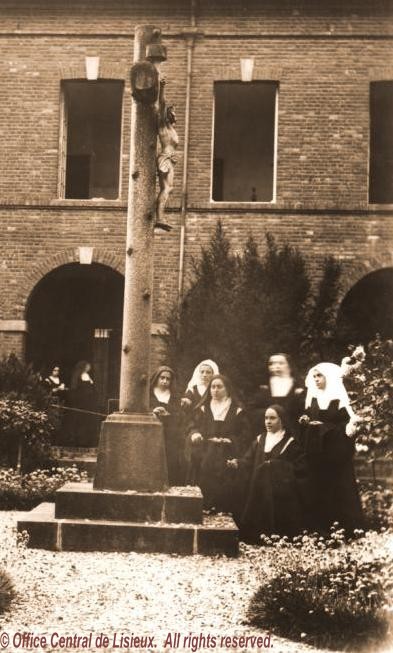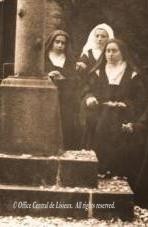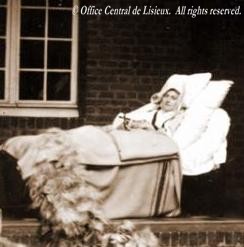Saint Therese of the Child Jesus
of the Holy Face
Entries in Francis La Neele (1)
Listen to Jeanne Guerin, the cousin of St. Therese of Lisieux, singing Therese's poem "An unpetalled rose"
As a gift for Saint Therese's feast, the Web site of the archives of the Carmel of Lisieux presents a small miracle. After having shared so many treasures you can see, they now offer one you can hear. The Carmel has a wax cylinder recording of St. Therese's cousin, Jeanne Guerin, singing Therese's poem "An unpetalled rose," and the Archives succeeded in making it possible for you to listen to it on the Internet.
Jeanne married Dr. Francis La Neele, who occasionally treated Therese during her illness. Click here to see a photo of Jeanne and here to see a photo of Francis. At the end of the song Francis can be heard congratulating her: "Bravo, my little wife! Bravo! It's very good! More! More!" She answers him by singing a light little verse, not part of Therese's poem, that ends with the words "Bravo bravo bravo." Please read the story and listen to the three-minute recording here.
As far as I know, this is the first time in history that a recording has been released of voices heard by St. Therese. "Merci" to the Carmel!
The story of the poem "An Unpetalled Rose"
Sister Marie of the Trinity, Therese's novice, who had spent two years at the Paris Carmel before entering at Lisieux, wrote to Mother Agnes on January 17, 1935:
Yesterday, the singing of the "Unpetalled Rose" brought back to my mind a cherished memory. Mother Marie-Henriette of the Paris Carmel, on Messine Avenue, had asked me to beg Sister Thérèse to compose a poem on this subject. As this corresponded with the sentiments of our dear Saint, she put her whole heart into the composition. Mother Henriette was very happy to receive it, only she wrote to tell me that a last stanza was missing; it should explain that God, at death, would gather together these plucked petals to form them into a beautiful rose which would shine for all eternity. Then Sister Thérèse said to me:
"Let the good Mother make the stanza herself as she understands it; as for me, I'm not in the least bit inspired to do so. My desire is to be unpetalled forever in order to give joy to God. Period. That's all!"*
*(St. Therese of Lisieux: Her Last Conversations, tr. John Clarke, OCD. Washington, D.C.: Washington Province of Discalced Carmelites, Inc., 1977).
See the text Therese wrote, dated May 19, 1897. (You may also hear it sung by Sylvie Buisset, with the same text but a different melody). This poem makes clear that, although the image of the rose has been popularly associated with Therese as a sign of the favors she would send ("After my death I will let fall a shower of roses"), during her lifetime she saw herself as the "unpetalled rose." The rose plucked apart, the petals mere "debris"--this was an image of her complete gift of herself to God. On June 28, 1896, in her poem "Strewing Flowers," Therese has already expressed herself on this theme:
Lord, my soul is in love with your Beauty.
I want to squander my perfumes and my flowers on you.
In strewing them for you on the wings of the breeze,
I would like to inflame hearts.

The introduction to that poem explains the photo above:
Every night during June of 1896, Therese and the five young sisters in the novitiate would meet after Compline [night prayer]--about eight o'clock--at the granite Cross in the courtyard. They would gather the petals shed beneath the twenty or so rose bushes there and throw them at the Crucifix. Therese would say "Let's see whose will go highest and touch the Face of our good Jesus!" (Sister Marie of the Eucharist, 6/24/1896). Therese herself would carefully choose her petals so as to strew only "very fresh ones" (Sister Genevieve, PO, p. 309).*
*The Poetry of St. Therese of Lisieux, tr. Donald Kinney, OCD. Washington, D.C.: Washington Province of Discalced Carmelites, Inc., 1996, pp. 158-159.

Note that this photo was taken in 1897, but by that time Therese was too sick to join the novices except for this one photo. The crucifix in the courtyard, called a "Calvaire," was the gift of Mr. and Mrs. Leroyer, the parents of Sister Therese of St. Augustine. Therese's cousin and Jeanne's younger sister, Sister Marie of the Eucharist, in the black veil, is with Therese next to Sister Marie-Madeleine, who, as a lay sister, wore the white veil all her life.

On August 30, 1897, Mother Agnes of Jesus, Therese's sister Pauline, wrote:
"We placed her on a folding bed and rolled her out onto the cloister walk up to the choir door. We left her there alone for a good length of time. She was praying with her eyes facing the grille. Then she cast some rose petals towards it. We photographed her before bringing her in."
Last Conversations, p. 175. (The reference to the grille means that Therese was looking toward the Blessed Sacrament, which was reserved in the public chapel, on the far side of the grille). In the photograph one can see the rose petals lying around the crucifix on Therese's blanket; in The Hidden Face, Ida Goerres calls this gesture "a touching parable of her own mute, defenceless surrender." Therese's poem reveals a depth of meaning one would hardly guess from the light song we hear Jeanne singing!